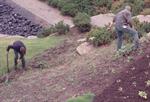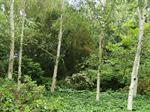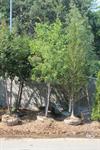 Develops an understanding of environmental systems and the rehabilitation of degraded landscapes.
Develops an understanding of environmental systems and the rehabilitation of degraded landscapes.
You learn about seed collection, storage and germination, propagation, plant selection, establishment techniques, controlling pest and disease after planting.
COURSE STRUCTURE
There are ten lessons are as follows.
 1. Approaches To Land Rehabilitation: Erosion Control, Understanding Plants and Plant Identification, Land Management Programs, Soil Degradation, Erosion, Salinity, Adicification and Compaction, Rehabilitation.
1. Approaches To Land Rehabilitation: Erosion Control, Understanding Plants and Plant Identification, Land Management Programs, Soil Degradation, Erosion, Salinity, Adicification and Compaction, Rehabilitation.
2. Ecology Of Soils And Plant Health: Ecosystems, Indigenous Plants, Habitat Corridor Creation, Design Considerations, Edge Effects, Soils, Physical and Chemical Characteristics of Soils, Improving Soils, Plant Nutrition, Diagnosing Nutritional Problems, Pests and Diseases.
3. Introduction To Seed Propagation Techniques: Seed Propagation, Germinating Difficult Seeds, Sowing, Propagation Containers, Tubing Seedlings, Production Systems, Seed Germination.
4. Propagation And Nursery Stock: Propagating Cuttings, Types of Cuttings, Stock Plants, Hormone Treatments, Cutting Grafts, Light Treatments, Spread of Pests and Diseases, Propagating Mixes and Media, Maintenance of Plants in Pots, Greenhouses.
5. Dealing With Chemical Problems: Soil Contamination, Soil Rehabilitation, Chemical Composition of Soils and Plant Growth.
6. Physical Plant Effects On Degraded Sites: Pioneer Plants, Protecting Sites, Windbreaks, Shelter belts, Firebreaks, Storm water, Water logging and Drainage, Soil Compaction.
7. Plant Establishment Programs: Planting for Specific Climates, Selection Criteria, Planting, Protecting Plants.
8. Hostile Environments: Planning, Rehabilitation Techniques, Mulching, Weed Management, Salt Tolerant Trees and Shrubs.
9. Plant Establishment Care: Planting Procedures - Evergreens, Deciduous Plants, Water and Plant Growth, Inspecting Plant Health, Examining Plant and Immediate Environment, Prioritising Problems, Research.
10. Rehabilitating Degraded Sites: Environmental Assessments, Land Rehabilitation Management Plans, Determining and Implementing a Program.
 AIMS
AIMS
- Compare different approaches to land rehabilitation, to determine strengths and weaknesses of alternative options on a site to be rehabilitated.
- Visit, identify and determine techniques to maximise plant development in land rehabilitation situations.
- Explain the different ways of producing seedling trees for land rehabilitation purposes.
- Determine appropriate plant establishment programs for particular sites.
- Develop procedures to care for plants, during establishment in an hostile environment.
- Manage the rehabilitation of degraded soil.
- Explain the effect of plants on improving a degraded site, both physically and chemically.
EXAMPLES OF WHAT THE COURSE COVERS
Here are just some of the things you will be doing:
-Determine different examples of land degradation.
-Explain different reasons for land requiring rehabilitation, including:
- Salination
- Erosion
- Mining
- Grazing
- Vegetation harvesting
- Pests
- Reduction of biodiversity
- Soil contamination
- Urbanisation.
-Compare the effectiveness of different policy approaches to land rehabilitation by different agencies and organisation, including:
- Different levels of government
- Mining companies
- Developers
- Conservation groups (i.e. tree planting bodies, landcare groups).
-Develop a risk analysis for a specified site to be rehabilitated, by determining a variety of plant health problems which may impact on the success of plant establishment.
-Analyse the failure of plants to grow successfully on a visited land rehabilitation site.
-Develop a procedure to enhance the success rate of land rehabilitation plantings on a degraded site you visit.
-Describe the use of mulches, to maximise plant condition in a specified land rehabilitation tree planting project.
 -Explain different processes of establishing seedlings on land rehabilitation sites, including:
-Explain different processes of establishing seedlings on land rehabilitation sites, including:
- tubestock nursery production
- direct seeding
- pre-germinated bare rooted seedlings.
-Determine factors which affect the viability of establishing five different species of plant seedlings, from five different plant families; on a specific degraded site.
-Compare the benefits of acquiring plants for a project by buying tubestock, with propagating and growing on, or close to, the planting site, with reference to:
- costs
- plant quality
- local suitability
- management.
-Prepare production schedules for a plant species, using different propagation techniques, summarising all important tasks from collection of seed to planting out of the tubestock.
-Calculate the cost of production for a tubestock plant, according to the production schedule developed by you.
-Estimate the differences in per plant establishment costs, for tubestock, compared with direct seeding methods, for planting on a degraded site.
-Describe three different methods of planting trees for rehabilitation purposes.
-Describe different plant establishment techniques, including:
- wind protection
- frost protection
- pest control
- water management
- weed management.
-Describe an appropriate method for preparing soil for planting, at a proposed land rehabilitation site in your locality.
-Evaluate plant establishment techniques used by two different land rehabilitation programs inspected by you at least twelve months after planting was carried out.
-Determine the needs of plants after planting, on two different proposed land rehabilitation sites.
-Describe different, efficient ways, of catering to the needs of large numbers of plants after planting.
-Collect pressed specimens or photographs of twenty trees for a herbarium of suitable trees for rehabilitation, and including information on the culture and care of each tree.
-Describe different types of soil degradation, detected in your locality.
-Determine the risk factors involved in soil degradation, relevant to your locality.
-Compare two different alternative methods of treating each of different soil degradation problems identified and inspected by you.
-Develop an assessment form to use for evaluating the sensitivity of a site to land degradation.
-Evaluate a site showing signs of degradation, selected by you, using the assessment form you developed.
-Plan a rehabilitation program for the degraded site you evaluated, including
- a two year schedule of work to be completed;
- list of quantity and type of materials required;
- approximate cost estimates.
-Explain the effect different plant species may have resisting soil degradation.
-Explain how different plants can have different impacts upon the chemistry of their environment, including both air and soil.
-Evaluate the significance of a group of plants, to the nature of the microclimate in which you find them growing.
-Compare the appropriateness of twenty different plant species for different degraded sites.
-Determine plant varieties, suited to each of six different degradation situations.
Duration: 100 hours